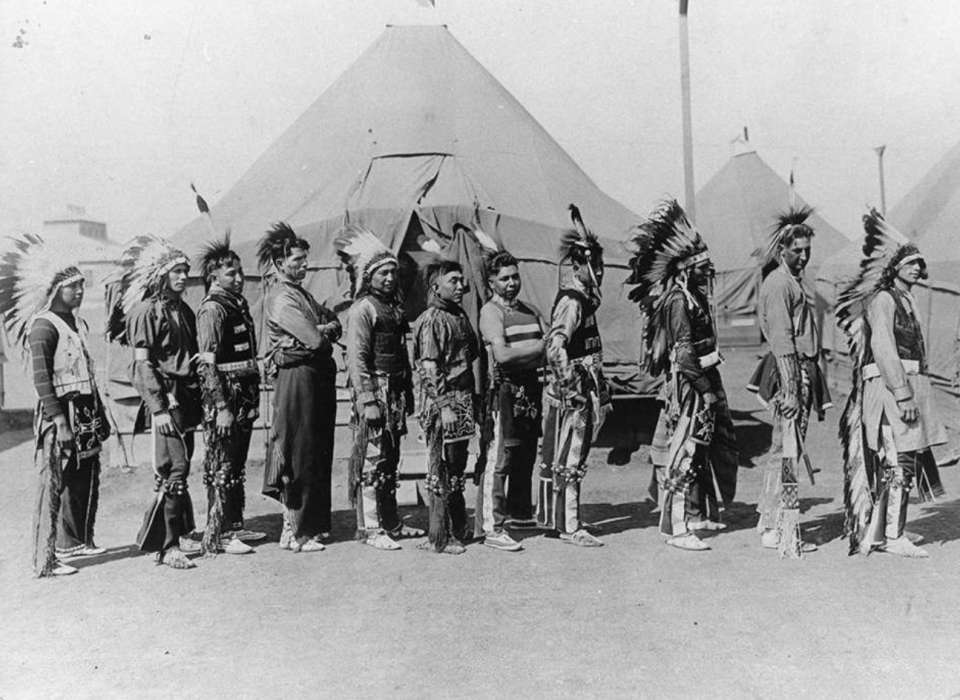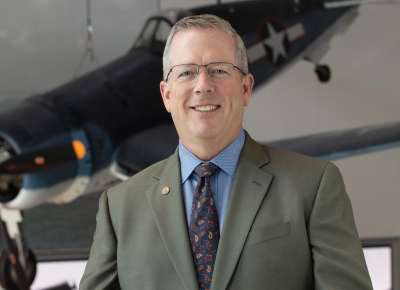Top image: Native Americans of the 45th Infantry Division, 1917. Indigenous peoples have a long history of service to the nation. Native Americans from more than 50 tribes served in every military service during World War II, and in many roles supporting the war effort from the Home Front as well. Image courtesy of the 45th Infantry Division Museum.
While Navajo code talkers of World War II have been featured in several books and, in 2002, a Hollywood movie, in recognition of Indigenous Peoples’ Day it is important to remember that members of many different tribes served in this role. In fact, the US military first recruited Native Americans to use their language as communications experts and messengers during World War I. This was also just one of the many ways in which Native Americans from dozens of tribes not only served in combat units during World War II, but also contributed both individually and collectively to the United States’ war effort on the Home Front.
Even before the war began, Native Americans showed their support for the nation’s defense by registering for Selective Service. This was complicated by the fact that most Indigenous peoples lived on remote reservations and spoke dialects that few outside their communities could understand, and despite the fact that many were reluctant to submit to US government authority without fully understanding what this would entail. Complicating matters further, military officials differed in their understanding of Native Americans’ citizenship status, while Selective Service, the Justice Department, and the Indian Bureau argued about their authority and jurisdiction over the process.
Still, Native Americans ultimately achieved a near-100 percent registration rate for the draft, a goal met largely because of the help administrators received from members of First Nations communities. For example, Barney Old Coyote of the Crow tribe served as a machine gunner for the Army Air Forces and then, after the war, worked as a translator for the Bureau of Indian Affairs and as an adviser to President Johnson on Native American matters. People like Barney Old Coyote could explain government policy to Native Americans in their own language, helping overcome the effects of a history of disenfranchisement that denied Indigenous peoples’ economic opportunity, education equality, and even the right to vote in many states. In time, their belief in defending the homeland and their pride in resisting the efforts of totalitarian nations to oppress other societies led Native Americans overwhelmingly to support the draft. In return, they hoped that their contribution to the war effort would help them earn their proper place as fully enfranchised American citizens after the war.
Indigenous peoples’ Home Front service during World War II went far beyond registering for the draft. Despite the poverty and labor shortages prevalent throughout the reservation system, by 1944 Native Americans spent $50 million on war bonds, while donating cash, crops, and handmade craft items to organizations such as the Red Cross. Once the war began, many Native American women went to work in the defense industry, took jobs on reservations to alleviate the shortage of male workers, or enlisted in organizations like the Women’s Army Corps (WAC). Gracie Thorpe, daughter of the famous athlete Jim Thorpe, served in the WAC during the war, and worked as a tribal judge and anti-nuclear activist after she returned home.
Collectively, Native American tribes made resources available to the US government through leases of land for use as military training areas, sources of vital war materials like oil and other natural resources, and even camps for the internment of Japanese citizens. In some cases, the government took resources without a tribe’s consent, did not give fair compensation, or refused to return land after the war, but usually these arrangements were mutually beneficial over the long term.
In the aftermath of the Japanese attack on Pearl Harbor, Native Americans swept up in the national surge of patriotism rushed to volunteer for military service. Over the course of the war, 25,000 Indigenous men served in combat. This amounted to nearly a third of all Indigenous men between the ages of 18 and 50 who could pass their physical exam. They served in every branch of the military, in every theater of war. Unlike Black soldiers, Native Americans could enlist in both combat and combat support roles from the beginning of the war, and they were not restricted to segregated units.
For example, more than 2,000 Native Americans from over 50 tribes served in the 45th Infantry Division, the “Thunderbird Division.” When the division mobilized and deployed to Abilene, Texas, for training, both their fellow soldiers and members of the local community had to overcome the effects of stereotyping in popular media, which often portrayed Native Americans as savages.
Fortunately, these soldiers not only performed exceptionally well in their military training; they also went to great lengths to showcase their culture, performing ceremonial music and dance in both military and civilian community venues. Ultimately, Native American soldiers received three of the eight Medals of Honor awarded to troops of the 45th Division. The success of Indigenous soldiers in the Thunderbird Division is but one example of the successful integration and combat excellence of Indigenous peoples in World War II.
Many Americans returning from the war experienced a challenging transition back to civilian life. For many Native Americans, the joy and relief that came with victory soon shifted to disappointment, as they found themselves once again marginalized and subject to discriminatory prewar policies. Still, their expectation for inclusion in the postwar recovery led to a wave of activism that, over time, increased public awareness of the challenges they faced and respect for their wartime service to the nation.
The President’s recent proclamation establishing Indigenous Peoples’ Day represents a positive step in this process by setting aside a day each year to recognize the contribution not only of Native Americans to the United States’ victory in World War II, but of all Indigenous Peoples to the security and prosperity of the Nation.
Mark T. Calhoun, PhD
Mark T. Calhoun, PhD, is a former Senior Historian at the Jenny Craig Institute for the Study of War and Democracy.
Cite this article:
MLA Citation:
APA Citation:
Chicago Style Citation:






![Max Fuchs, New York City cantor, sings as Rabbi Sydney [sic] Lefkowitz, Richmond, VA, conducts the first Jewish services from Germany.](/sites/default/files/styles/max_650x650/public/2025-10/image1.jpg)


